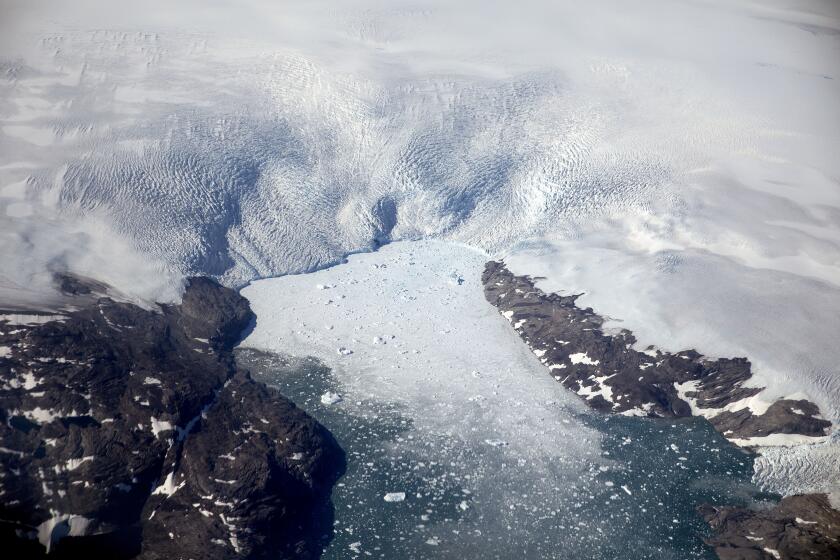
- Share via
Deadly heat in the Southwest. Hot-tub temperatures in the Atlantic Ocean. Sweltering conditions in Europe, Asia and South America.
That 2023 was Earth’s hottest year on record was in some ways no surprise. For decades, scientists have been sounding the alarm about rapidly rising temperatures driven by humanity’s relentless burning of fossil fuels.
But last year’s sudden spike in global temperatures blew far beyond what statistical climate models had predicted, leading one noted climate scientist to warn that the world may be entering “uncharted territory.”
“It’s humbling, and a bit worrying, to admit that no year has confounded climate scientists’ predictive capabilities more than 2023 has,” wrote Gavin Schmidt, director of NASA’s Goddard Institute for Space Studies, in a recent article in the journal Nature.
Aggressive and impactful reporting on climate change, the environment, health and science.
Now, he and other researchers are scrambling to explain why 2023 was so anomalously hot. Many theories have been proposed, but “as yet, no combination of them has been able to reconcile our theories with what has happened,” Schmidt wrote.

Last year’s global average temperature of 58.96 degrees Fahrenheit was about a third of a degree warmer than the previous hottest year in 2016, and about 2.67 degrees warmer than the late 1800s pre-industrial period against which global warming is measured.
While human-caused climate change and El Niño can account for much of that warming, Schmidt and other experts say the extra three or four tenths of a degree is harder to account for.
Theories for the increase include a 2020 change in aerosol shipping regulations designed to help improve air quality around ports and coastal areas, which may have had the unintended consequence of enabling more sunlight to reach the planet.
The 2022 eruption of the Hunga Tonga-Hunga Ha‘apai volcano also shot millions of tons of water vapor into the stratosphere, which scientists say helped to trap some heat. What’s more, a recent uptick in the 11-year solar cycle may have contributed about a tenth of a degree of additional warning.
With a global average temperature of 58.96 degrees, the year was nearly one-third of a degree warmer than the previous hottest year on record, according to officials.
But these factors alone cannot explain what’s happening, Schmidt said.
“Even after taking all plausible explanations into account, the divergence between expected and observed annual mean temperatures in 2023 remains about 0.2 °C — roughly the gap between the previous and current annual record,” he wrote in his report.

Reached by phone, Schmidt said he thinks one of three things could be going on.
It’s possible that 2023 was a “blip” — a perfect storm of natural variables and Earth cycles lining up to create one freakishly hot year. Should that prove to be the case, “it won’t have huge implications for what we’re going to see in the future, because it would have been just such a rare and unlikely thing that is not going to happen again anytime soon,” he said.
However, he indicated that’s unlikely, as those elements “have never lined up to give us a blip this large.”
Another possibility is that scientists have misunderstood the driving forces of climate change. While greenhouse gases, volcanic eruptions and aerosols are known to affect global temperatures, perhaps the full extent of their effects have been underestimated or miscalibrated. Should that be the case, he said, research and data sets will hopefully catch up soon.
The last explanation he offered is that the system itself is changing — and changing in ways that are faster and less predictable than previously understood.
“That would be worrying because science is really all about taking information from the past, looking at what’s going on, and making predictions about the future,” Schmidt said. “If we can’t really trust the past, then we have no idea what’s going to happen.”
Every bit of planetary warming will have impacts beyond those already occurring, including biodiversity loss, longer heat waves and extreme rainfall.
Not everyone agrees with his assessment, however. Michael Mann, a professor in the Department of Earth and Environmental Science at the University of Pennsylvania, said the premise that 2023’s warmth cannot be explained — or that it is inconsistent with model simulations — is “simply wrong.”
“The situation is extremely similar to what we saw during the 2014-2016 period as we transitioned from several years of La Niña conditions to a major El Niño event, and then back to La Niña,” Mann said in an email.
In fact, he said some recent modeling shows the global temperature spike in 2016 was even more of an outlier than that of 2023.
“The plot shows that the surface warming of the planet is proceeding almost precisely as predicted,” Mann said. “And the models show that the warming will continue apace as long as we continue to burn fossil fuels and generate carbon pollution.”
When asked about this interpretation, Schmidt said it’s true that the 2014 to 2016 period was similarly anomalous. But there is a key difference between then and now, he said.
The 2016 temperature spike came on the heels of an El Niño event, with the biggest anomalies in February, March and April of the year following its peak, he said. He noted that similar patterns occurred after previous El Niños in 1998 and 1942.
Conversely, last year’s spike arrived in August, September, October and November — before the peak of El Niño — “and that has never happened before,” Schmidt said. “It never happened in the temperature record that we have. It doesn’t happen in the climate models.”
New research warns of a possible collapse in Atlantic Ocean currents due to climate change. That could fundamentally alter global weather patterns.
Alex Hall, a professor of atmospheric and oceanic sciences at UCLA, said he largely agrees with Schmidt’s assessment that the hypothesized factors alone can’t account for the large temperature anomaly experienced in 2023 and early 2024. He likened it to the emergence of megafires, or extreme wildfires, in the last decade, which wasn’t entirely foreseen.
“What we’ve learned is that there’s an aspect of this that isn’t fully predictable — that we don’t fully understand — and that we are tempting fate here a little bit by continuing to interfere with the climate system,” Hall said. “It’s going to do things that we don’t understand, that we don’t anticipate, and those are going to have potentially big impacts.”
Hall said the rapid transition from a persistent La Niña to a strong El Niño last summer likely played a role, as did the change in aerosol regulations.
He also posited that the rapid loss of Antarctic sea ice in 2023 — itself an outcome of the warmer planet and oceans — could have created a kind of feedback loop that contributed to more warming. Ice and snow are reflective, so when they melt, it can result in a darker ocean that absorbs more heat and sunlight. (Antarctic sea ice coverage dropped to a record low in 2023, according to the National Oceanic and Atmospheric Administration.)
“It’s sort of a planetary emergency for us to figure out what’s going on when we see these types of changes,” Hall said. “There should be large teams of people working on it to try to understand it, and we don’t really have those kinds of efforts, so I think there’s lessons, too, for the need for focus on this particular topic.”

While he and other scientists may not agree on just how extraordinary 2023 was — or what was behind its exceptional warmth — they all acknowledged the clear signs of a planet being pushed to its limits.
“I think it’s unfortunate that so much has been made of the El Niño-spiked 2023 global temperatures, where in my view there is nothing surprising, or inconsistent with model predictions, there,” said Mann. “There are much better, scientifically-sound reasons to be concerned about the unfolding climate crisis — particularly the onslaught of devastating weather extremes, heat waves, wildfires, floods, drought, which by some measures are indeed exceeding model predictions.”
Last year was marked by extreme weather events, with more billion-dollar disasters in the United States than any other year, according to NOAA. Among them were the Lahaina wildfire in Hawaii in August; Hurricane Idalia in Florida that same month; and severe flooding in New York in September.
Already this year, January and February have continued the global hot streak, marking nine consecutive months of a record-breaking temperatures.
In his Nature article, Schmidt said the inexplicable elements of the recent warming have revealed an “unprecedented knowledge gap” in today’s climate monitoring, which drives home the need for more nimble data collection that can keep up with the pace of change.
He noted it may take researchers months or even years to unpack all the factors that could have played a part in the sizzling conditions.
“We need answers for why 2023 turned out to be the warmest year in possibly the past 100,000 years,” he wrote. “And we need them quickly.”
Though El Niño is expected to wane this summer, there is still a 45% chance that this year will be warmer than 2023, according to NOAA.
It is a near certainty however that 2024 will rank among the five hottest years on record — so far.
Toward a more sustainable California
Get Boiling Point, our newsletter exploring climate change, energy and the environment, and become part of the conversation — and the solution.
You may occasionally receive promotional content from the Los Angeles Times.











